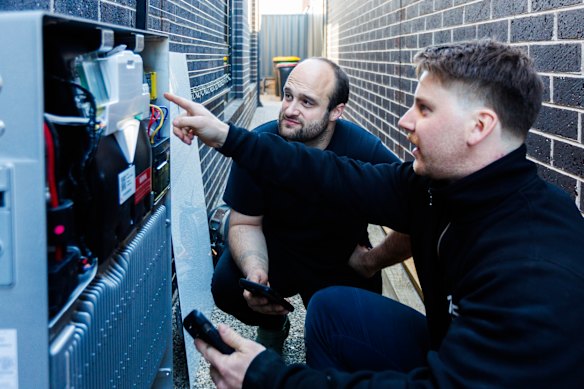By Mike Foley
Demand for household batteries is surging under the Albanese government’s national rebate, with retailers reporting a fourfold rise in sales and inquiries as the scheme kicked off.
However, experts warn householders that while spending thousands of dollars on a battery can dramatically cut annual power bills, it may not deliver rapid returns on investment.

Allan Lancaster (left), of Truganina, Melbourne, and battery installer Haidyn Boothey of the 1komma5 supply company. Credit: Aaron Francis.
The Cheaper Home Batteries Program was one of the government’s key election pledges, offering a 30 per cent rebate on the purchase and installation cost of a battery from July 1.
Quote-comparison service SolarQuotes, owned by Origin Energy, reported a jump in battery inquiries in the lead-up to the scheme.
“The volume for May was 400 per cent higher than the previous month, and about two-thirds of all quote requests are now for home batteries,” said Chris Zondanos, Origin general manager electrification.
The scheme is limited to homes with solar panels, but householders without are eligible for the discount if they install panels and a battery at the same time.
Scope for uptake is huge. Solar panels already soak up the sun on 4 million of the nation’s 11 million homes. But just 250,000 have batteries.
Battery installation company 1komma5 provided the discount to customers before the scheme kicked in. It can now claim the money back from the government.
“We’ve seen a 459 per cent increase in battery sales in the May to June period this year compared to last year,” said 1komma5 Australia chief executive Luke Stronach. “It’s changing the whole profile of the industry.”
A household battery delivers savings by charging on free solar power from rooftop panels during the day and discharging at night to power the house when demand on the electricity grid rises, driving up prices.
Industry and government calculations show a household battery can cut a typical power bill by about $1000 a year, which could more than halve the annual power bills of many Sydney and Melbourne residents.
However, Grattan Institute energy director Alison Reeve said householders should not expect to ditch their bills altogether – even if they buy big batteries.
“Eliminating your power bills takes a large amount of responsibility,” Reeve said. “You’ve got to stop and think about it every time you want to flick a switch. It’s not impossible, but it does really change how you live your life.
“This is normally sufficient storage to meet an average household’s needs for power overnight until the solar comes back online. Although if you own an electric car and use it for long commutes every day, or have a big house with central electric heating and cooling, then more capacity is likely to be needed.”
There are about 80 household batteries on the Australian market, starting at about $4000 for a five-kilowatt-hour unit, according to data compiled by industry group the Smart Energy Council.
The nine systems on the market with a 10-kilowatt-hour capacity range from $6000 to $10,000, and the Tesla Powerwall 3, which has a 13.5-kilowatt-hour capacity, can retail for more than $18,000.
Tristan Edis, head of analysis at energy consultancy Green Energy Markets, said the typical size of a household battery system historically had been about 10 to 15 kilowatt-hours. The price of a large battery was not necessarily significantly higher than a smaller unit, given installation costs were a large chunk of the price, Edis said.
The scheme is not capped on dollar amounts but by battery size – limited to one system per premises – with five to 50-kilowatt-hour capacity eligible for support, and total capacity not exceeding 100 kilowatt-hours.
The government’s scheme is not limited by the income of buyers and total cost to taxpayers of the subsidy is not capped.
Experts have said widespread battery uptake would reduce electricity demand at peak times, putting downward pressure on power prices for households without solar panels or batteries.
Cut through the noise of federal politics with news, views and expert analysis. Subscribers can sign up to our weekly Inside Politics newsletter.